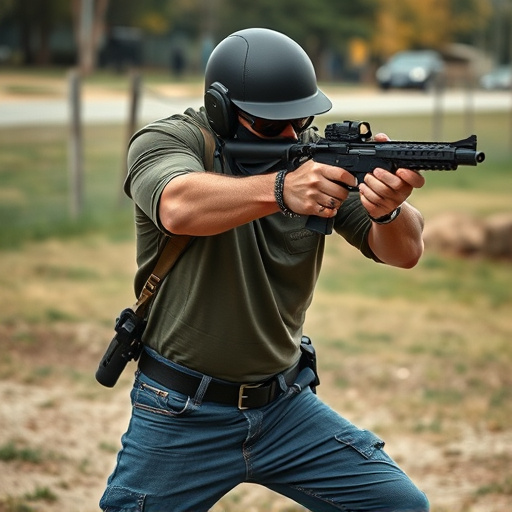Comfortable Grip Stun Guns: Design Innovations, Safety, and Side Effects
Stun guns, while effective for temporary incapacitation, pose significant neurological risks includi…….
Stun guns, while effective for temporary incapacitation, pose significant neurological risks including disorientation, muscle spasms, and potential long-term cognitive impairments. Recent advancements focus on user safety with ergonomic grips, advanced materials, and innovative designs to minimize hand injuries and side effects. Strict regulations govern stun gun possession and use globally due to these concerns, emphasizing the need for safe handling practices. Future trends aim to further reduce neurological impacts through targeted muscle stimulation and refined electrical current patterns.
“Discover the evolution of stun gun design, focusing on comfortable grip innovations that balance user safety with effectiveness. From understanding the immediate physiological impacts of stun guns—including their neurological side effects—to exploring regulatory frameworks and future trends, this article delves into the intricate world of stun gun technology. Learn how design advancements cater to users’ needs while addressing potential legal implications, particularly regarding stun gun neurological side effects.”
- Understanding Stun Gun Functionality and Its Immediate Effects
- Neurological Impacts: Short-Term and Potential Long-Term Side Effects
- Design Innovations for Enhanced User Comfort and Safety
- Regulatory Considerations and Legal Implications of Comfortable Grip Stun Guns
- Exploring Alternative Designs and Future Trends in Stun Gun Technology
Understanding Stun Gun Functionality and Its Immediate Effects

Stun guns, also known as electronic control devices (ECDs), operate by delivering a high-voltage, low-amperage electrical discharge to disrupt an individual’s nervous system temporarily. When activated, the stun gun generates a powerful electric current that flows through the target’s body, causing immediate physiological responses. The primary effect is the disruption of muscle control and balance, leading to a loss of coordination and, in many cases, severe pain. This rapid response can incapacitate an assailant, providing users with a crucial window of opportunity to escape potentially dangerous situations.
The neurological side effects of stun guns are significant. The electrical current disrupts the electrical signals transmitted through the nervous system, temporarily overloading the brain’s ability to process information. This can result in temporary disorientation, confusion, and even short-term memory loss. Additionally, the intense stimulation can trigger a range of physical responses, including muscle spasms, nausea, and in rare cases, more severe medical complications. Understanding these effects is essential for users to appreciate the device’s power and ensure safe handling and minimal impact on bystanders.
Neurological Impacts: Short-Term and Potential Long-Term Side Effects

Stun guns, while designed to incapacitate an attacker momentarily, can have significant neurological impacts on the user and bystanders alike. The electrical current discharged from a stun gun is intended to disrupt muscle control, but it also directly affects the nervous system. Short-term effects include intense pain, muscle spasms, disorientation, and temporary paralysis. These symptoms typically subside within minutes or hours after exposure.
However, potential long-term neurological side effects remain a cause for concern. Studies suggest that repeated exposure to stun guns could lead to more severe consequences, such as chronic pain, nerve damage, and even cognitive impairments. The high voltage and frequency of the electrical pulses can disrupt neural pathways, potentially causing lasting changes in sensory perception and motor function. As such, it’s crucial to consider the broader health implications of stun gun use beyond their immediate effectiveness in self-defense scenarios.
Design Innovations for Enhanced User Comfort and Safety

In recent years, stun gun designs have evolved significantly, with a strong focus on enhancing user comfort and safety. One of the primary concerns in stun gun development has been mitigating the neurological side effects associated with their use. Manufacturers are introducing innovative features like ergonomic grip designs that ensure users can maintain a firm yet comfortable hold, reducing strain during activation. This is crucial for ensuring accurate deployment and minimizing accidental discharges.
Additionally, advanced materials and padding are being integrated into stun gun casings to absorb impact and prevent injuries to the user’s hand. These design innovations not only make the device more user-friendly but also address potential safety hazards. By prioritizing comfort and reducing physical stress, these new designs empower users to defend themselves effectively while minimizing the risk of adverse neurological side effects.
Regulatory Considerations and Legal Implications of Comfortable Grip Stun Guns

The development and distribution of stun guns with comfortable grips must adhere to stringent regulatory considerations, especially given the potential for misuse and the associated neurological side effects. Many countries have strict laws governing the possession and use of stun devices due to safety concerns. These regulations often require manufacturers to implement specific design features that ensure user safety and minimize harm. Comfortable grip designs, while aiming to enhance usability, must not compromise the overall safety profile of the stun gun.
Legal implications are significant when considering stun guns with ergonomic handles. Manufacturers and distributors must be cognizant of the potential for abuse and the impact on public safety. The risk of stun guns being used as weapons against vulnerable individuals, particularly in situations where force is not justified, raises important legal questions. As such, regulatory bodies often implement guidelines that balance personal protection with the need to prevent harm, ensuring that comfortable grip designs do not contribute to an increase in unnecessary violence or have unforeseen neurological side effects.
Exploring Alternative Designs and Future Trends in Stun Gun Technology

As technology advances, stun gun designs are evolving beyond traditional models, exploring alternative forms and features to enhance effectiveness and user experience. One prominent trend is the integration of advanced materials and ergonomic principles to achieve a comfortable grip. Designers are moving away from the standard rectangular shape, experimenting with compact, curved, or even concealed designs that reduce hand fatigue during extended use.
Looking ahead, future trends in stun gun technology may include improved safety mechanisms and reduced neurological side effects. Researchers are investigating new technologies like targeted muscle stimulation and advanced electrical current patterns to minimize the impact on the body’s nervous system. These innovations aim to provide users with a safer alternative while still delivering powerful stun capabilities, addressing public concerns regarding stun guns’ potential neurological consequences.
In conclusion, while stun guns offer a crucial self-defense tool, it’s essential to balance their effectiveness with user comfort and safety. By understanding the neurological impacts of stun guns, embracing design innovations that prioritize a comfortable grip, and navigating regulatory considerations, we can ensure these devices serve their purpose without causing undue harm. As stun gun technology continues to evolve, exploring alternative designs and keeping pace with future trends will be vital for enhancing user safety and mitigating potential neurological side effects.


